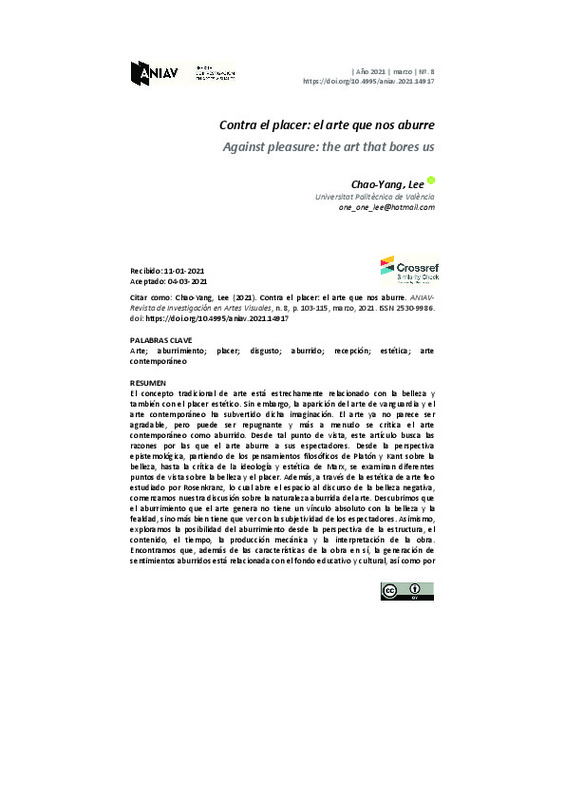|
Resumen:
|
[EN] The traditional concept of art is closely related to beauty and also to aesthetic pleasure. However, the emergence of avant‐garde and contemporary art has subverted that imagination. Art no longer seems to be pleasant, ...[+]
[EN] The traditional concept of art is closely related to beauty and also to aesthetic pleasure. However, the emergence of avant‐garde and contemporary art has subverted that imagination. Art no longer seems to be pleasant, but it can also be disgusting and tedious, just like contemporary art that has often been criticized as such. From this point of view, this article attempts to look at the reasons why some art bores its viewers. From the epistemological perspective, we start to examine the philosophical thoughts of Plato and Kant on art, and the critique of Marxist ideology and aesthetics, exploring different perspectives on aesthetic beauty and pleasure. Furthermore, through the aesthetics of ugliness studied by Rosenkranz, of which opens the space for the discourse of negative beauty, we start our deduction of boredom in art. We discover that boredom generated by art does not have an absolute link with beauty and ugliness, but rather it has to do with the subjectivity of the viewers. With the examination of boredom from the perspective of the structure, content, time, mechanical production, and interpretation of the work, we have found that in addition to the characteristics of the work itself, the production of boredom is related to the educational and cultural background of the spectator, as well as to one´s personal taste. Finally, we also question whether art has begun to be boring and unremarkable after the historical progress of art being suspended, owing to “the end of art” suggested by Danto.
[-]
[ES] El concepto tradicional de arte está estrechamente relacionado con la belleza y también con el placer estético. Sin embargo, la aparición del arte de vanguardia y el arte contemporáneo ha subvertido dicha imaginación. ...[+]
[ES] El concepto tradicional de arte está estrechamente relacionado con la belleza y también con el placer estético. Sin embargo, la aparición del arte de vanguardia y el arte contemporáneo ha subvertido dicha imaginación. El arte ya no parece ser agradable, pero puede ser repugnante y más a menudo se critica el arte contemporáneo como aburrido. Desde tal punto de vista, este artículo busca las razones por las que el arte aburre a sus espectadores. Desde la perspectiva epistemológica, partiendo de los pensamientos filosóficos de Platón y Kant sobre la belleza, hasta la crítica de la ideología y estética de Max, se examinan diferentes puntos de vista sobre la belleza y el placer. Además, a través de la estética de arte feo estudiado por Rosenkranz, lo cual abre el espacio al discurso de la belleza negativa, comenzamos nuestra discusión sobre la naturaleza aburrida del arte. Descubrimos que el aburrimiento que el arte genera no tiene un vínculo absoluto con la belleza y la fealdad, sino más bien tiene que ver con la subjetividad de los espectadores. Asimismo, exploramos la posibilidad del aburrimiento desde la perspectiva de la estructura, el contenido, el tiempo, la producción mecánica y la interpretación de la obra. Encontramos que, además de las características de la obra en sí, la generación de sentimientos aburridos está relacionada con el fondo educativo y cultural, así como por el gusto personal del espectador. Por último, también nos preguntamos si el progreso histórico del arte comenzó a parecer aburrido y sin nada nuevo después de que Danto llegara a la conclusión del fin del arte.
[-]
|









